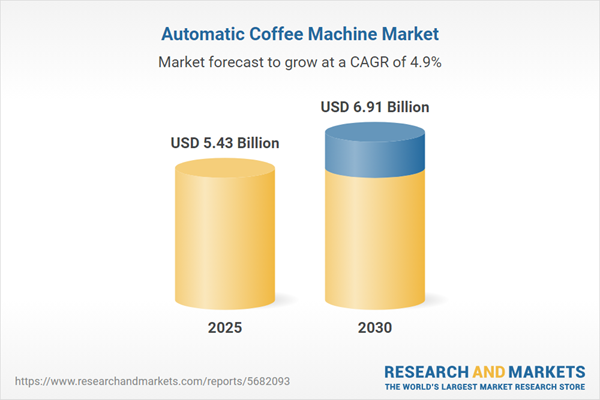Automatic coffee machines are utilized in various settings, including homes, offices, cafés, and restaurants, to prepare a diverse range of coffee beverages. The rise in disposable incomes and improved living standards, along with increasing urbanization, has led to a surge in coffee consumption. This growing demand for coffee, coupled with the proliferation of quick-service restaurants and cafés worldwide, is driving the need for automatic coffee machines. The convenience offered by these machines is particularly appealing in offices and homes, as they ensure consistent quality by controlling brewing parameters. This reliability enhances customer satisfaction and further boosts demand.
Drivers of the Global Automatic Coffee Machines Market:
- Increasing Coffee Consumption: The market for automatic coffee machines is being propelled by rising coffee consumption. With busy lifestyles, many individuals are turning to coffee for an energy boost due to its caffeine content. The growing workforce is contributing to this trend, as more people seek convenient ways to enjoy their coffee. Additionally, awareness of the health benefits associated with moderate coffee consumption - such as reduced risks of liver cancer and Parkinson’s disease - is encouraging higher consumption levels at home and in workplaces. This shift is driving demand for automatic coffee machines that facilitate the easy and quick preparation of various coffee beverages.
Geographical Outlook of the Global Automatic Coffee Machines Market:
- Asia-Pacific as the Fastest-Growing Market: The global automatic coffee machine market is segmented into five regions: North America, South America, Europe, the Middle East and Africa, and Asia Pacific.
- Europe: This region represents a significant market for automatic coffee machines, driven by increasing coffee consumption and the rise of specialty cafés in several countries. The growing coffee culture in nations such as Ireland, Hungary, and the Czech Republic will further support regional market growth in the coming years.
- North America: North America is also expected to maintain a substantial market share due to rising coffee consumption in the U.S. and Canada. According to statistics from the United States Department of Agriculture (USDA), the U.S. is the second-largest importer of coffee beans from countries like Brazil, Colombia, Vietnam, and Guatemala. The presence of numerous specialty coffee stores in this region is another key factor contributing to the growing demand for automatic coffee machines.
- Asia Pacific: The Asia Pacific region is projected to experience significant growth driven by an expanding middle-class population. The influence of Western culture on lifestyle and taste preferences is shaping the automatic coffee machine market in this area. The 2023 China Urban Coffee Development Report highlighted that Shanghai has the highest number of coffee shops globally, with 8,530 stores - an increase of 673 from 2022 - accounting for 6.4% of the national total. Additionally, the growth of global coffee shops and cafés in countries such as India, Australia, and Thailand is further fueling demand for automatic coffee machines.
Reasons for buying this report:
- Insightful Analysis: Gain detailed market insights covering major as well as emerging geographical regions, focusing on customer segments, government policies and socio-economic factors, consumer preferences, industry verticals, other sub-segments.
- Competitive Landscape: Understand the strategic maneuvers employed by key players globally to understand possible market penetration with the correct strategy.
- Market Drivers & Future Trends: Explore the dynamic factors and pivotal market trends and how they will shape up future market developments.
- Actionable Recommendations: Utilize the insights to exercise strategic decision to uncover new business streams and revenues in a dynamic environment.
- Caters to a Wide Audience: Beneficial and cost-effective for startups, research institutions, consultants, SMEs, and large enterprises.
What do businesses use our reports for?
Industry and Market Insights, Opportunity Assessment, Product Demand Forecasting, Market Entry Strategy, Geographical Expansion, Capital Investment Decisions, Regulatory Framework & Implications, New Product Development, Competitive Intelligence.Report Coverage:
- Historical data & forecasts from 2022 to 2030
- Growth Opportunities, Challenges, Supply Chain Outlook, Regulatory Framework, Customer Behaviour, and Trend Analysis
- Competitive Positioning, Strategies, and Market Share Analysis
- Revenue Growth and Forecast Assessment of segments and regions including countries
- Company Profiling (Strategies, Products, Financial Information, and Key Developments among others)
The Global Automatic Coffee Machines Market has been segmented as following:
- By Type
- Semi-Automatic
- Fully Automated
- By Product Type
- Residential
- Commercial
- By Sales Channel
- Online
- Offline
- By Geography
- North America
- USA
- Canada
- Mexico
- South America
- Brazil
- Argentina
- Others
- Europe
- United Kingdom
- Germany
- France
- Spain
- Others
- Middle East and Africa
- Saudi Arabia
- UAE
- Israel
- Others
- Asia Pacific
- China
- Japan
- South Korea
- Australia
- India
- Indonesia
- Thailand
- Others
- North America
Table of Contents
Companies Mentioned
- Koninklijke Philips N.V.
- Melitta Professional Coffee Solutions GmbH & Co. KG
- JURA Vertrieb (Schweiz) AG
- De’Longhi Appliances S.r.l.
- WMF GmbH
- Morphy Richards
- Panasonic Malaysia Sdn Bhd.
- Behmor, Inc.
- Gaggenau Hausgeräte
- Keurig Green Mountain, Inc.
Methodology

LOADING...
Table Information
| Report Attribute | Details |
|---|---|
| No. of Pages | 135 |
| Published | January 2025 |
| Forecast Period | 2025 - 2030 |
| Estimated Market Value ( USD | $ 5.43 Billion |
| Forecasted Market Value ( USD | $ 6.91 Billion |
| Compound Annual Growth Rate | 4.9% |
| Regions Covered | Global |
| No. of Companies Mentioned | 10 |









